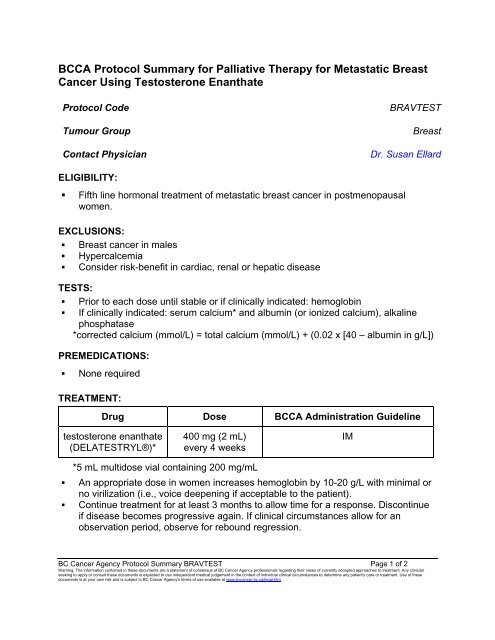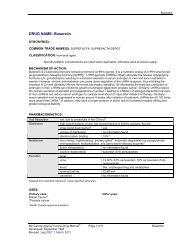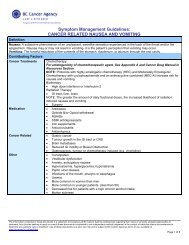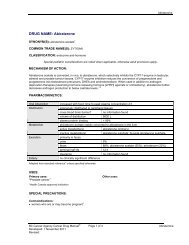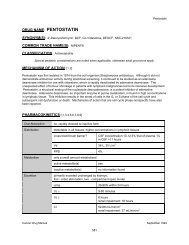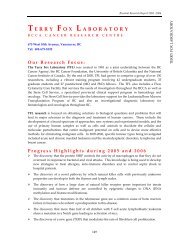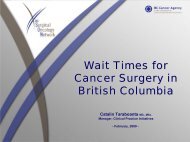Protocol - BC Cancer Agency
Protocol - BC Cancer Agency
Protocol - BC Cancer Agency
- No tags were found...
Create successful ePaper yourself
Turn your PDF publications into a flip-book with our unique Google optimized e-Paper software.
<strong>BC</strong>CA <strong>Protocol</strong> Summary for Palliative Therapy for Metastatic Breast<strong>Cancer</strong> Using Testosterone Enanthate<strong>Protocol</strong> CodeTumour GroupContact PhysicianBRAVTESTBreastDr. Susan EllardELIGIBILITY:• Fifth line hormonal treatment of metastatic breast cancer in postmenopausalwomen.EXCLUSIONS:• Breast cancer in males• Hypercalcemia• Consider risk-benefit in cardiac, renal or hepatic diseaseTESTS:• Prior to each dose until stable or if clinically indicated: hemoglobin• If clinically indicated: serum calcium* and albumin (or ionized calcium), alkalinephosphatase*corrected calcium (mmol/L) = total calcium (mmol/L) + (0.02 x [40 – albumin in g/L])PREMEDICATIONS:• None requiredTREATMENT:Drug Dose <strong>BC</strong>CA Administration Guidelinetestosterone enanthate(DELATESTRYL®)*400 mg (2 mL)every 4 weeksIM*5 mL multidose vial containing 200 mg/mL• An appropriate dose in women increases hemoglobin by 10-20 g/L with minimal orno virilization (i.e., voice deepening if acceptable to the patient).• Continue treatment for at least 3 months to allow time for a response. Discontinueif disease becomes progressive again. If clinical circumstances allow for anobservation period, observe for rebound regression.<strong>BC</strong> <strong>Cancer</strong> <strong>Agency</strong> <strong>Protocol</strong> Summary BRAVTEST Page 1 of 2Warning: The information contained in these documents are a statement of consensus of <strong>BC</strong> <strong>Cancer</strong> <strong>Agency</strong> professionals regarding their views of currently accepted approaches to treatment. Any clinicianseeking to apply or consult these documents is expected to use independent medical judgement in the context of individual clinical circumstances to determine any patient's care or treatment. Use of thesedocuments is at your own risk and is subject to <strong>BC</strong> <strong>Cancer</strong> <strong>Agency</strong>'s terms of use available at www.bccancer.bc.ca/legal.htm
DOSE MODIFICATIONS:1. Dose Escalation• Escalate dose by one level if there is insufficient hemoglobin rise with no virilizationand no evidence of a response.LevelDosestandardincrease 1 levelincrease 2 levels400 mg (2 mL) IM every 4 weeks400 mg (2 mL) IM every 3 weeks400 mg (2 mL) IM every 2 weeks2. Dose Reduction• Reduce dose by one level if there is significant edema, unacceptable virilization orexcessive increase in hemoglobin.LevelDosestandarddecrease 1 leveldecrease 2 levels400 mg (2 mL) IM every 4 weeks300 mg (1.5 mL) IM every 4 weeks200 mg (1 mL) IM every 4 weeksPRECAUTIONS:1. Hypercalcemia: Androgen therapy may worsen hypercalcemia due to metastaticbreast cancer.2. Tumour growth stimulation: Androgen therapy occasionally acceleratesdisease progression. Close monitoring is required, especially during the earlystages of therapy.3. Virilization: Some effects such as voice changes or clitoromegaly may not bereversible. The patient and physician must decide how much virilization will betolerated before dose reducing or discontinuing. To prevent virilization,discontinue when signs of mild virilization appear and before the processbecomes irreversible.4. Injection site reactions: IM injections of androgens have been associated withlocal urticarial and injection reactions (induration, furunculosis).Call Dr. Susan Ellard or tumour group delegate at (250) 712-3900 or 1-888-563-7773 with any problems or questions regarding this treatment program.Date activated:01 Nov 2001 (replaces fluoxymesterone)<strong>BC</strong> <strong>Cancer</strong> <strong>Agency</strong> <strong>Protocol</strong> Summary BRAVTEST Page 2 of 2Warning: The information contained in these documents are a statement of consensus of <strong>BC</strong> <strong>Cancer</strong> <strong>Agency</strong> professionals regarding their views of currently accepted approaches to treatment. Any clinicianseeking to apply or consult these documents is expected to use independent medical judgement in the context of individual clinical circumstances to determine any patient's care or treatment. Use of thesedocuments is at your own risk and is subject to <strong>BC</strong> <strong>Cancer</strong> <strong>Agency</strong>'s terms of use available at www.bccancer.bc.ca/legal.htm
Date revised:01 May 2009 (unsafe abbreviations and symbols replaced,physician contact revised)<strong>BC</strong> <strong>Cancer</strong> <strong>Agency</strong> <strong>Protocol</strong> Summary BRAVTEST Page 3 of 2Warning: The information contained in these documents are a statement of consensus of <strong>BC</strong> <strong>Cancer</strong> <strong>Agency</strong> professionals regarding their views of currently accepted approaches to treatment. Any clinicianseeking to apply or consult these documents is expected to use independent medical judgement in the context of individual clinical circumstances to determine any patient's care or treatment. Use of thesedocuments is at your own risk and is subject to <strong>BC</strong> <strong>Cancer</strong> <strong>Agency</strong>'s terms of use available at www.bccancer.bc.ca/legal.htm


